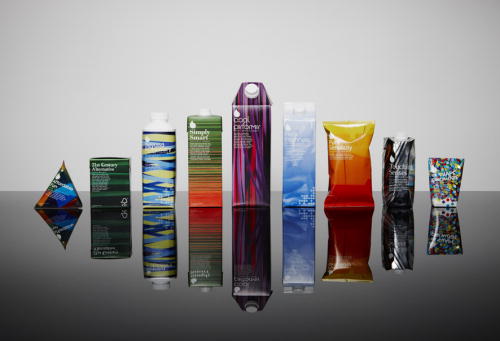Several of Europe’s biggest economies recycle less drink carton than previously thought, shows a recent report from Zero Waste Europe. New EU rules for calculating packaging recycling rates reveal that countries and manufacturers still lag behind in making beverage cartons more environmentally-friendly and need to step up their efforts to reach Europe’s ambitions for a circular economy.
What’s Inside a Carton
Enter a supermarket and is highly unlikely you will miss them: beverage cartons. They host long-life and fresh milk, non-dairy milk alternatives, juices, sauces, and sometimes soups. The combination of materials layered in the cartons makes them lightweight but strong, prevents leakages and protects foods from contamination, while prolonging products’ shelf lives. Cartons’ block shape makes them easy to store and transport.
The average drink carton is a composite, a multi-layer material containing about 75% fibreboard (i.e. paper), 21% plastic (or other synthetic polymer) and 4% aluminium; the figures vary, with paper content ranging between 53% and 80%, depending on the packaging’s function, size, and market. With its main component comes primarily from certified wood, beverage carton is deemed to be the lowest greenhouse gas emitter compared to PET, HDPE, glass bottles, metal cans, and stand-up pouches. But emerging recycling standards challenge its environmental performance.
The New EU Rules and the Drop in Recycling Performance for Beverage Cartons
In 2019 and 2020, on average just above half of all (51%) beverage cartons placed on the EU market were recycled, according to the Alliance for Beverage Cartons and the Environment (ACE). This suggests that the rest ends up either mixed up with other waste or incinerated, says the Zero Waste Europe report. But even the 51% rate might be overstated, if recycling rates are revised under the EU’s new rules on packaging, says the study. From 2022, the recycling rate for composite packaging will be calculated based on recyclability of each of the materials making up the item, unless their proportion is insignificant (under 5%).
The study focuses on the cases of Germany, Spain, Sweden, and the UK (no longer a EU member, but having pledged last year to transpose EU rules on packaging post-Brexit), whose recycling performance for beverage cartons drops drastically under new regulation: Germany’s 75% recycling rate becomes 47.8%; Spain drops from 80% to 21.4%; Sweden from 33% to 21.9% and the UK’s rate of beverage carton recycled falls from 36% to 29.5%.
“The four countries are broadly representative, including high, low and medium recycling rates,” says Vera Lahme, consultant and co-author of the report commissioned by Zero Waste Europe, to Renewable Matter. “It is expected that all currently reported recycling rates in the EU will likely decrease significantly when the new reporting methods become compulsory. ACE currently holds data to the current recycling rates, but these are not calculated using the new calculation method and we are unsure of how these are calculated. We found that these rates overstate what is actually happening in the market for our 4 case studies and we expect this to be the case for the other EU countries as well, with the average recycling rate for Europe being significantly lower than that claimed by the beverage carton industry.”
Official numbers for recycled beverage carton amounts could be even lower, according to Zero Waste Europe. Calculating the recycling rate using the packaging’s original weight, i.e. the “placed on the market” weight, can falsely inflate results, as disposed beverage cartons contain non-packaging materials, including residues of products, dirt, or other contaminants, often get counted as recycled packaging.
Beverage Carton Has a Problem with Circularity
Several factors challenge countries and packaging manufacturers in making beverage carton comply with the principles of a circular economy. Collection is one factor. Beverage carton collection rates vary widely across countries, from top collector Germany (87.4%), to Spain (51,2%), the UK (48%), and Sweden (40.1%), with lower collection rates increasing the risk of having cartons incinerated rather than recycled.
Then there is the carton’s composite nature. Paper is recyclable, but plastic and aluminium are not, so sorting beverage carton requires manual sorting or more advanced technology to spot non-paper elements. Some countries collect carton separately from paper and cardboard (e.g. Germany), while others pick everything together (e.g. Sweden), which can lead to sorting mistakes. Furthermore, regular paper mills cannot easily process and recycle the paper content in beverage cartons, which require specialised operations. But Europe counts only 20 such plants, which cannot keep up with the entire amount of carton waste collected and sorted. For example, in the UK, about 60,000 tonnes of material gets onto the market, but its only specialist mill can process only 25,000 tonnes, while Germany’s three specialised plants provide coverage for the entire country. Specialised mills in the four countries studied use the so-called “single separation method”, which separates paperboard fibres from aluminium and polyethylene layers using water in what resembles a washing machine drum.
Still, that means about a quarter of a drink carton gets incinerated. As the new rules look at the recyclability of each raw material making up the package, putting the plastic and the aluminium out of use severely undermines recyclability performance, already affected by losses in collection, sorting, and processing waste. So far efforts to recycle carton’s non-paper components has been financially non-viable. “Specialist mills have smaller material throughput than more ‘general’ paper mills,” explains Lahme. “In addition, the process is more energy-intensive and time consuming and produces more waste – although it also produces high-quality paper products. But overall the economics do seem to be more challenging than for conventional mills.”
An increased focus on how recyclable is each component in carton also refocuses attention on the longevity of their useful life and on carton’s overall circularity. The EU Commission’s 2020 Circular Economy Action Plan sees circularity as “an essential part of a wider transformation of industry towards climate-neutrality and long-term competitiveness,” and reducing waste from packaging is a top priority. But in a circular economy, products and materials should be maintained as long as possible, says NGO Food Packaging Forum: a particular challenge for beverage cartons and particular nature.
Fuelling Deforestation
Making beverage cartons requires high-quality, long wooden fibres found mostly in slow-growing coniferous forests at northern latitudes. Recycled fibres are too short to be raw material for cartons, locking beverage cartons in a dependency on virgin fibre sources. As Europe strives for a net-zero-carbon economy, beverage cartons raise concern for their role in fuelling deforestation of carbon-rich forests and their higher environmental impacts relative to average packaging board, stresses Zero Waste Europe. But this also raises concerns about their circularity. Even when using specialised pulping infrastructure to recycle cartons, recovered paper fibres are shorter than the original raw material; they cannot become part of a new round of cartons, and get downcycled into lower-grade cardboard, which means closed loop recycling is impossible.
Safety Concerns for Recycled Materials in Food Packaging
Innovating beverage carton design could be a game changer for packaging circularity, says the report. Tetra Pak, the largest food packaging company globally, aims to increase carton’s reliance on renewable and recycled materials by using plant-based alternatives to fossil fuel produced plastics, and by using more recycled polymers and paper. But using recycled materials for food packaging raises safety concerns, as unsafe chemicals might migrate to food and drinks, warned Jane Muncke, managing director for Food Packaging Forum, at a recent ACE event on packaging sustainability in the EU. This creates a bottleneck for carton manufacturers. “We have committed to use recyclable plastic in our packaging, if it’s safe and available,” said Heike Schiffler, Tetra Pak vice president for sustainability for Europe and Central Asia at the same event. “But we cannot compromise on safety. Where recyclable materials are available, end market applications are not so easy to open to these materials, there is a lot of resistance.” Further questions remain on how innovation can address carton’s reliance on long-fibres and its inevitable downcycling after use.
Collection and Deposit Refund Schemes
Finding solutions for chronic collection and sorting issues is also critical for increasing carton’s circularity. Deposit Refund Schemes (DRS) - that ask people for a small additional payment which they get back upon returning the empty packaging to recycle - could be the most effective solution for maximising collection rates, states the report, as they help collect between 80 and 99% of beverage packaging. Separate carton collection would also lower the complexities and errors within sorting and processing. Setting recycling targets is also key. Across the four countries studied, only Germany has a dedicated 75% recycling target for beverage cartons.
“The priority lies with an improved collection and sorting system as this forms the basis for effective recycling”, says Lahme. “An improved design would only yield minimal improvements in recycling if the cartons are not captured in the first place or are lost in sorting processes. But the recycling infrastructure (specialised paper mills) also needs to be there to recycle as much of the collected material as possible.”



